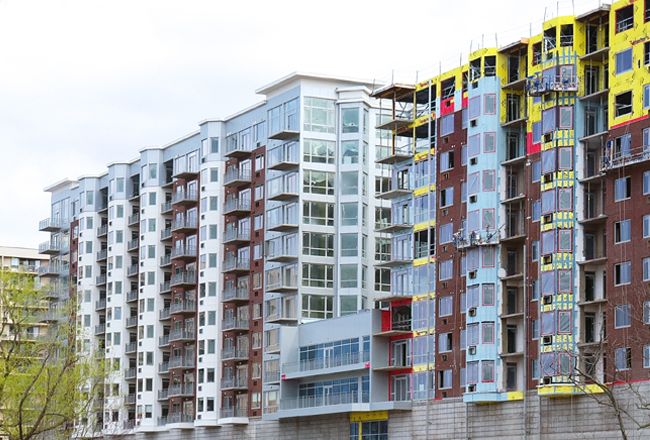
Targeting the county”™s growing millennial and empty nester populations, Westchester County is adding apartments at a rate double its historic average. But as national indicators point to a possible slowdown in commercial real estate lending, can that pace continue?
The Wall Street Journal recently reported that 2016 lending for commercial property was down about 3 percent from 2015, citing numbers from the Mortgage Bankers Association. Most of the decline occurred in the fourth quarter, when lending volume was 7 percent lower than the fourth quarter of 2015.
An April report in the Financial Times said Federal Reserve officials have made commercial real estate risks a larger focus this year, ordering banks to examine how they would fare if commercial real estate prices dropped by 35 percent and rental apartment values fell even further.
While lower than in 2015, the $491 billion in mortgage loans for commercial real estate last year represents the third highest year since the Mortgage Bankers Association started tracking the numbers. Of that total, the $214 billion that went to multifamily properties led all other commercial property types.
Developers and bank officers in Westchester say that there is still funding to be found for multifamily projects in the county, so long as the proposal itself is strong.
“There may be concern about projects that could be considered marginal or projects that lenders are looking suspiciously at,” said Martin Ginsburg, principal and founder of Valhalla-based Ginsburg Development Cos. “We aren”™t experiencing that problem. Right now, the market is strong, particularly for the type of development we are doing.”
Ginsburg Development”™s recent luxury apartment projects include the $65 million, 118-unit Harbor Square apartment building on the Ossining riverfront and the $35 million, 66-unit The Lofts on Saw Mill River apartment complex in Hastings-on-Hudson. Next month, the company expects to hold a grand opening for the $100 million River Tides at Greystone luxury apartment project, which will add 330 units on Warburton Avenue in Yonkers.
“There”™s huge potential in Westchester,” Ginsburg added. “One of the problems Westchester had is that it had so few high-quality apartments and so few new apartments, that a lot of people that might have gone to Westchester didn”™t even consider it.”
Now the county is rapidly adding to its apartment stock. Between 2016 and 2018, about 2,200 new market-rate rental units will be added to its multifamily inventory, according to estimates by Admiral Real Estate Services. That represents a rate double the historic average and will increase the county”™s overall inventory by about 2 percent, according to Admiral.
“What we”™re seeing, if there is a slowdown in banks’ lending, it”™s more due to individual banks lessening exposure to multifamily because they were previously very aggressive,” said commercial real estate broker John Barrett, vice president of sales at Admiral in Bronxville. “It was the one asset class viewed as being immune to a downturn.”
But banks will likely keep an eye on the increasing supply and what the competition could mean for rent prices and vacancy rates.
A survey of 70 domestic banks released in January by the Federal Reserve found that lending standards for commercial real estate loans of all types tightened during the fourth quarter of 2016. About 41 percent of banks surveyed by the Fed said lending standards for loans secured by multifamily residential properties would tighten somewhat, though about half said the standards would likely remain unchanged.
A quarterly survey by the National Multifamily Housing Council, also released in January, found 74 percent of the 148 executives surveyed from apartment development firms think January was a worse time for multifamily mortgage borrowing than three months earlier.
“The stronger sponsors will be able to get financing,” said Robin Gallagher, senior vice president of commercial real estate at Webster Bank. “For the others, there are alternative lenders that are providing construction financing,” citing as examples private equity debt funds and insurance companies.
Gallagher said lenders are likely to offer more conservative loan-to-cost ratios. Last year, lenders offered 65 to 75 percent loan-to-cost, Gallagher said, while now most lenders are more in the 50 to 60 percent range.
John M. Tolomer, president and CEO of The Westchester Bank, said any slowdown nationally would likely come from banks and other lenders that focused heavily on multifamily lending backing away.
“There are a number of banks that have made a significant amount of multifamily loans, so as their concentrations get out of their comfort zone, they tend to retreat from the market,” Tolomer said. He added that multifamily as an asset class has performed well and will likely to continue to do so in the metropolitan New York market.
Unlike the New York City market, both Westchester and Fairfield counties still have plenty of room to grow to meet demand, according to Joseph Apicella, managing director of development a MacQuesten Development LLC, a Pelham-based developer.
“New York City was five years ahead of us in terms of producing product and putting it into the marketplace,” he said. “Westchester County and Fairfield County are grossly underserved for the millennial and empty nester population.”
MacQuesten has developed a number of projects in both New York City and Westchester. They includes a proposal for the $71 million, 176-unit 22 S. West Street Tower in Mount Vernon, which Apicella said the company hopes to get approved by the city before summer. MacQuesten just opened The Modern in Mount Vernon, an 11-story, 81-unit building at 13 Mount Vernon Ave. targeted for residents with workforce incomes. MacQuesten is also in the third stage of construction for the 228-unit Heritage Homes public apartment and townhouse complex in New Rochelle.
Apicella said the strength of Westchester”™s market for multifamily real estate investment is clear from the number of developers attracted here.
“You see it happening in White Plains, there are cranes in the air, you see it in New Rochelle, you see it in Yonkers,” he said. “I don”™t see anybody struggling to get financing on jobs that are solid, I don”™t see that at all.”























MacQuesten’s ugliest building in all land, The Modern, is an 81-unit affordable rental housing development at 130 Mount Vernon Avenue in Mount Vernon http://chigrants.org/development-projects/
If MacQuesten wants to build more Affordable PILOT program housing in Mount Vernon they will need to do it on their dime. They are asking for full financial assistance and PILOTS and we cannot afford to give it them.
We will be present at the PUBLIC IDA hearing on May 12th !